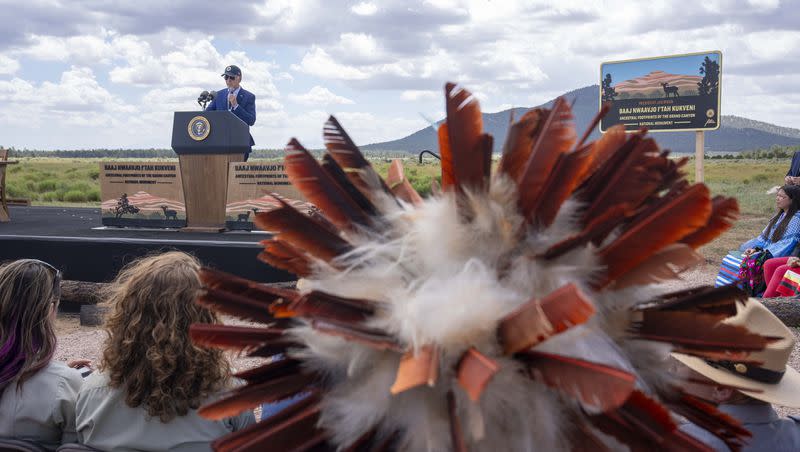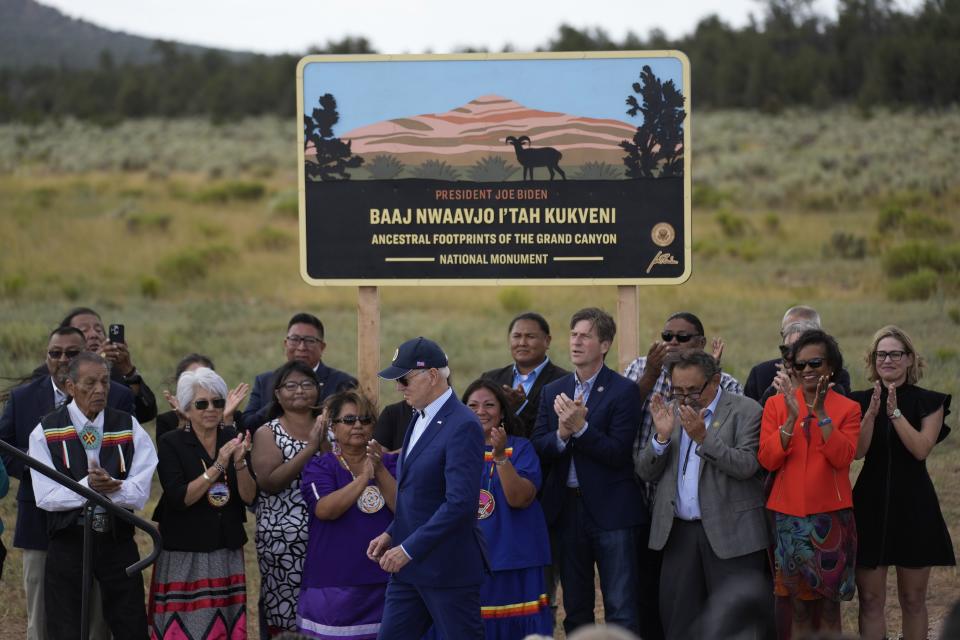New Arizona national monument is ‘frustrating news’ for Utah Gov. Cox

- Oops!Something went wrong.Please try again later.
At a time when the Biden administration is pursuing a carbon-free economy and pouring millions upon millions of dollars into the development of next generation nuclear technology, the Tuesday designation of a new national monument in Arizona is confounding to Utah Gov. Spencer J. Cox.
The monument designation locks up the richest uranium deposits in the United States for future mining in the Grand Canyon area. Uranium is needed for nuclear fuel and the area is rich in other deposits.
“They (monument designations) also needlessly restrict access to the critical minerals that are key to cellphones, satellites, U.S. defense systems and so many other American industries,” Cox said in a statement.
“This monument designation is frustrating news, especially for residents of Utah along the Arizona strip. As I’ve said many times before, massive, landscape-scale monuments like this are a mistake. These designations increase visitation without providing any additional resources for law enforcement and infrastructure to protect sensitive areas.”
Related
On his visit to Arizona amid a trip in the West that includes a stop Wednesday in Utah, Biden designated the 917,000 acre Baaj Nwaavjo I’tah Kukveni Grand Canyon National Monument in Arizona, bordering the nearby Grand Staircase-Escalante National Monument in the Kane County area but also encompassing lands south of Washington County.
It potentially impacts Hildale, which straddles the border of Arizona and Utah.

Cultural preservation
The monument designation had been sought by a number of Native American tribes to protect cultural resources in the region, numbering in the thousands. Those tribes include members of the Havasupai, Hopi and Hualapai tribes, as well as the Kaibab Paiute Tribe, the Las Vegas Band of Paiute, the Moapa Band of Paiutes, the Paiute Indian Tribe of Utah, the Navajo Nation, the San Juan Southern Paiute Tribe, the Yavapai-Apache Nation, the Pueblo of Zuni, and the Colorado River Indian Tribes.
Creation of the monument also had support by Arizona’s top political leaders such as Rep. Raúl Grijalva, D-Arizona, and Sen. Kyrsten Sinema, I-Arizona.
The new monument brought praise from environmental groups and some recreational organizations.
“The establishment of this monument is driven by a large group of tribes, and it is both timely and critical that their narrative be a central part of the story of what makes this area magnificent and worthy of greater protection and respect,” said Director of Campaigns Lauren Bogard with the Center for Western Priorities.
The designation brought praise in terms of its ability to protect against future mining.
“The area and watershed surrounding Grand Canyon National Park has been at risk from a resurgence of uranium mining, threatening ancestral tribal homelands, wildlife, and limited clean water supplies. This move provides permanent protections that will conserve valuable U.S. landscapes for generations to come,” said Nicole Gentile, senior director of conservation at the Center for American Progress.
Collin O’Mara, chief executive officer of the National Wildlife Federation, said the action is protective of tribes and wildlife.
“Generations of Indigenous Peoples and other residents of Arizona carry with them the mistakes of dangerous uranium mining. The creation of the Baaj Nwaavjo I’tah Kukveni — Ancestral Footprints of the Grand Canyon National Monument — cannot make them whole, but it will help spare future generations of people and wildlife from irreparable harm,” he said.
The tug-of-war over public lands
Utah Sen. Mitt Romney, R-Utah, did not echo the praise of environmental groups, citing the area’s extreme importance in the area of mining resources critical for the nation.
“The Arizona Strip is one of the most productive uranium mining districts in the country. By eliminating this important source of uranium, President Biden has increased both our dependence on Russia and China and our ultimate carbon footprint, while decreasing our energy efficiency. It is disappointing that with this proclamation, the president has once again ignored the concerns of those who live closest to the land.”
The prohibitions on new mining are against a backdrop of a uranium mining ban around the Grand Canyon issued under the Obama administration.
In a listening session in July, impacts to ranchers were also expressed as a concern over the designation.
“Although the national monument is located within the boundaries of Arizona, portions of the national monument will disproportionately affect ranchers in southern Utah by including a remote region of the state known as the Arizona Strip,” wrote Ron Gibson, president of the Utah Farm Bureau. “The Arizona Strip is geographically separated from the rest of Arizona, is sparsely populated and is culturally tied to Utah.”
Gibson pointed out that many ranchers in Kane and Washington counties graze their cattle at higher altitudes in southern Utah and later winter in the lower elevations found on the Arizona Strip.
Both Utah politicians — Cox and Romney — said they wish politics would stay out of the game of monument designations.
“National monuments have become a political football tossed back and forth as presidential administrations change,” Romney said, adding the designation continues the cycle of Antiquities Act abuse by the executive branch.
Cox said these monument creations need to be done a different way.
“I still believe the only right way to create large new land designations is through Congress in coordination with local leaders and residents, a process that brings all voices to the table and offers the necessary funding,” he said.

